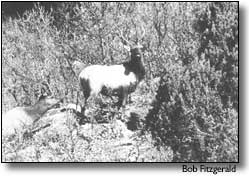|
Nov 3, 2001
BY JIM THOMAS A Pacific low pressure system this past Wednesday, Oct. 31, brought with it some rain but not much in the way of cold temperatures and snowfall, expect, perhaps at the highest elevations. Unfortunately a stronger, colder storm was expected to come into the Four Corners area by today, Nov. 3, the first day of the third big game hunting season in Colorado. But it has lost most of its punch. Some clouds and perhaps a snowflake a two over the very highest peaks and a little cooler temperatures are forecast for Sunday, Nov. 4.the first day of the third big game hunting season. But without some significant snowfall, the elk and deer will stay high in the dark timber, making tracking them difficult at best. Except for an early snow that arrived prior to the elk-only season on Oct. 13, the high country has been basking under warm temperatures and clear blue skies. The Colorado Division of Wildlife reported hunting pressure during the primitive seasons (muzzleloader and archery) was down, in part because fewer licenses were sold. Hunters during the primitive seasons, the special elk-only hunt, and the first (second hunt) combined rifle hunt had little to moderate harvest success. That’s partly because of a mild fall. Accompanied by above-average temperatures, the September-like weather made stalking nearly impossible for the second hunt, made it imperative that successful hunters get their meat to a processor as quickly as possible. Meanwhile, elk became wary of hunters and quickly moved into the comfort and safety of high terrain in the dark timber. Normally the busiest time of year for hunting, opening weekend of the third rifle big game season is usually a time when winter-like storms making tracking easier and quiets the woods. During the recently completed second hunt, the warm temperatures brought only moderate success. Wildlife officials had hoped the second rifle season would be as good as last year, which produced a record harvest for elk. But unseasonably warm and dry weather conditions have allowed elk to remain dispersed, making them difficult to track. It's no secret hunting success improves dramatically when there is snow on the ground. Elk aren't quite so elusive when there are fresh tracks to follow and enough snow will send them scurrying down to the better conditions found at lower elevations. Given the continued dry conditions, wildlife managers say hunters should be especially careful with fire. They advise visitors to check with the local county sheriff’s offices for possible fire restrictions. One good thing about the dry weather is that road conditions have improved. Hunters do not have to deal with muddy and impassable roads as they did during the first rifle season. But the DOW reminds hunters to be prepared for anything since weather conditions can change quite rapidly in Colorado. Once elk get moving, hunters usually have better luck. Successful elk hunting is weather dependent. Too little snow makes tracking difficult and too much snow means hunters have difficulty getting into the woods. If the predicted storm doesn’t bring at least six inches or more to the high country, then hunters will have to try and figure out where the elk and deer are hiding. Actually some luck may be on the hunter’s side for this weekend, though, even if there isn’t a lot of snow. The five-day break between the end of the second and today’s opening of the third hunting seasons might be enough to bring elk out of the dark woods to which they scurried during the previous season. With no hunting pressure, and with much of the high-elevation forage starting to dry, elk might feel safe enough to move into the places where green grass still can be found. Elk, even with no bad weather, will start moving again. Mother Nature dictates that. Elk will head down to the lower elevations in search of forage. The elk will still be in stands of Aspen or Fir, but not out in the parks quite yet. Hunters will likely have to get out and walk and walk and walk in order to stalk their game. Hunters, because they’ve had success in a certain year and hunt it year after year, may have to go out and hunt different places this year. |
||
|
Copyright © 2001 the Cortez Journal.
All rights reserved. |
